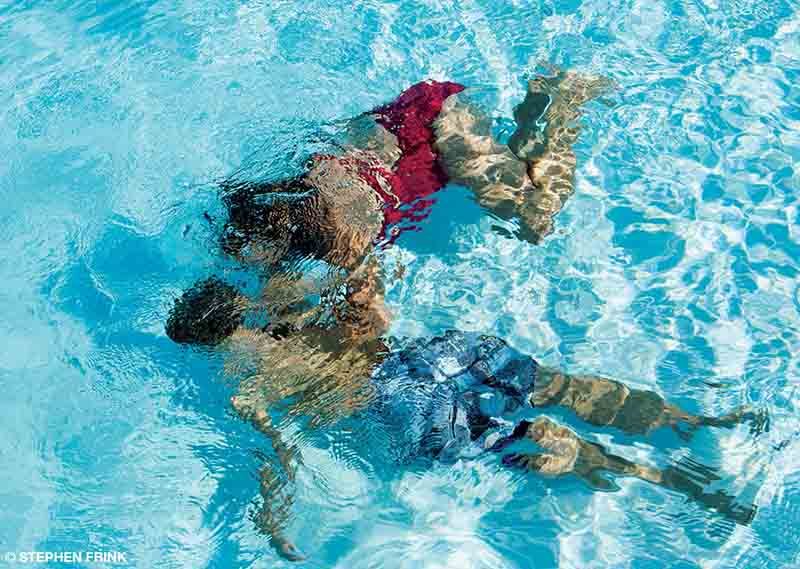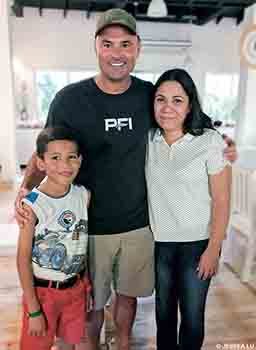I was in Roatan, Honduras, as a coach for my friend, fellow Performance Freediving International (PFI) instructor and 27-time Chinese national record holder Jessea Lu, as she competed in the 2017 Freediving Depth World Championship. The event had brought together the best and deepest divers in our sport — some of whom would be descending to more than 328 feet (and returning to the surface) on a single breath.

and an adult were lifting an unconscious boy out of the water.
The day before the competition I was walking alone to a meeting, and I heard a commotion as I passed a swimming pool at one of the beachside resorts. Several children and an adult were yelling and struggling to lift an unconscious boy out of the water. As I approached I could see that the boy’s lips and skin were blue. His eyes were half open and glazed, and pink foam oozed from his mouth. Kneeling at the boy’s side, I felt that his skin was cold, he had no pulse, and he was not breathing. For all intents and purposes, this boy was dead.
All PFI instructors are required to maintain DAN’s Diving Emergency Management Provider (DEMP) certification in first aid, and I had recently completed a refresher course. Thankfully, this was one of the exact situations we had trained for.
Per our training, I called on one bystander to summon an ambulance, another to seek an automated external defibrillator (AED) and another to get an oxygen unit from the resort’s dive shop. The crowd that had gathered primarily spoke Spanish, so I was grateful when a visiting retired Dallas, Texas, police detective named Armando loudly translated those instructions.
I then began doing single-rescuer CPR with chest compressions and rescue breaths at a 30:2 ratio. Pressing on the boy’s chest felt like pressing on a dead fish, and I feared the worst. When it came time for rescue breaths, I pinched his nose and blew into his mouth twice. I could feel the air going in, and I could see his chest rise, so I knew his airway was open.
Keep Your Skills Sharp
Get training in first aid and CPR, and refresh it regularly. Training gives you the confidence to step up and get involved and allows you to remain effective when the situation doesn’t unfold exactly as expected.
I continued CPR for several minutes until a round of rescue breaths caused vomit to be expelled from the boy’s mouth. Unfortunately, this was not a sign of consciousness but rather a mechanical result of fully inflated lungs and some air that entered the boy’s stomach. Armando and I rolled the boy onto his side, I used my finger to sweep the vomit out of his mouth, and we laid him back on his back to continue CPR. And so it went for seven or eight minutes, with no signs of life. By then we had learned that the resort did not have an AED, so I continued CPR.
Finally, something dramatic happened. After another round of rescue breaths, the boy vomited again. As we turned him onto his side to let the vomit and foam drain from his mouth, he struggled to cough and took the weakest of breaths. For the first time during this episode, the child showed a sign of life.
At this point, the oxygen unit arrived from the dive shop. As we held the boy on his side in the recovery position, I attached a demand-valve mask and regulator to the cylinder and placed it to the boy’s mouth. I could not detect any chest rise, but I could see condensation appearing and then disappearing on the inside of the mask with each weak breath, and I could hear him pulling ever so slightly on the valve, so I knew he was getting oxygen. I watched hopefully as his color improved.
Occasionally, the boy would reflexively vomit and stop breathing, at which point I would begin administering rescue breaths until his spontaneous breathing resumed. At this point we were about 20 minutes into the ordeal, and no ambulance had arrived. Soon, however, we were told that an ambulance was in front of the resort, so we loaded the boy onto a makeshift gurney and carried him to the lobby, stopping once along the way for more rescue breaths when he again ceased breathing.

whose life he had helped save.
As we approached the front of the resort, we were disappointed to see that there was no ambulance. There was, however, Fernando, the manager of the resort, in his sport utility vehicle (SUV). He told us he was a former race car driver, that the ambulance might not come, and that he would get us to the hospital. With no better option, Armando and I loaded the boy onto the back seat of the SUV and climbed in alongside him. The boy’s mother, who had arrived poolside within minutes and was understandably despondent, climbed into the front seat. With someone on a dirt bike in front of us honking his horn to clear traffic, we sped toward the hospital.
The 30-minute ride over the windy, hilly roads of Roatan at breakneck speed was like a scene out of The Dukes of Hazzard. Along the way, the boy, who was still unconscious, began screaming at the top of his lungs and thrashing wildly, after which he would return to relative calm. While this obviously distressed his mother, in this situation it was a welcome sign, as it meant that his level of responsiveness was improving. It did, however, make it difficult to keep the oxygen mask on his face, so I alternated between using the demand-valve mask when he tolerated it and a nonrebreather mask to “blow by” oxygen to his mouth and nose when he did not.
We eventually arrived at a small medical clinic and carried the still-unconscious boy, who I then knew was named Jose, into the clinic. Over the next 30 minutes, his blood oxygen level rose from 85 percent to an essentially normal 96 percent — another good sign.
With the situation under control, Armando and I said goodbye to Jose’s worried but relieved mother. I gave her my email address and asked her to send me a picture when he graduates from school, because I hoped he would now have that opportunity.
As Armando, the manager and I drove back to the resort, I could not help but wonder whether Jose had suffered brain damage. Would he ever truly recover?
The next day I went back to the resort seeking news about Jose’s condition and was told he was alert and talking and had no signs of brain damage. Doctors had drained his lungs and put him on antibiotics for aspiration pneumonia, but he was otherwise OK.
I stopped by the resort the next day for another update, and the desk clerk excitedly told me that he was back at the hotel and in the dining room eating lunch with his family.
I got to take a picture with Jose and his mother less than 48 hours after he drowned. It is the best picture I have had taken. I am so thankful to PFI for requiring me to maintain my DAN DEMP certification and to my instructor, Mauritius Valente Bell, for giving me the skills I needed to help save this child’s life.
| © Alert Diver — Q1 2018 |